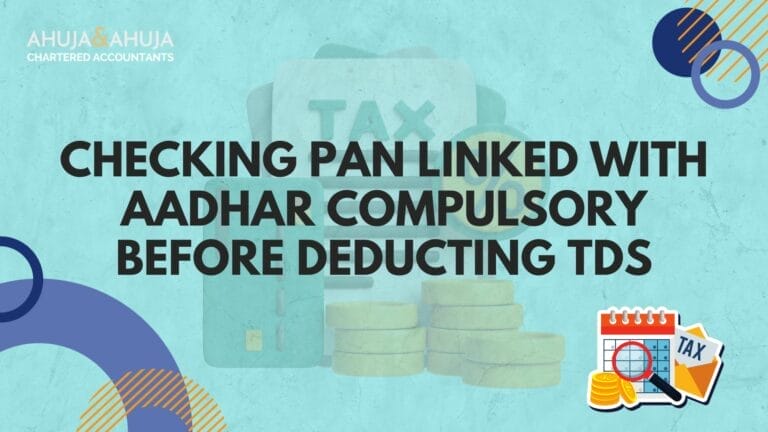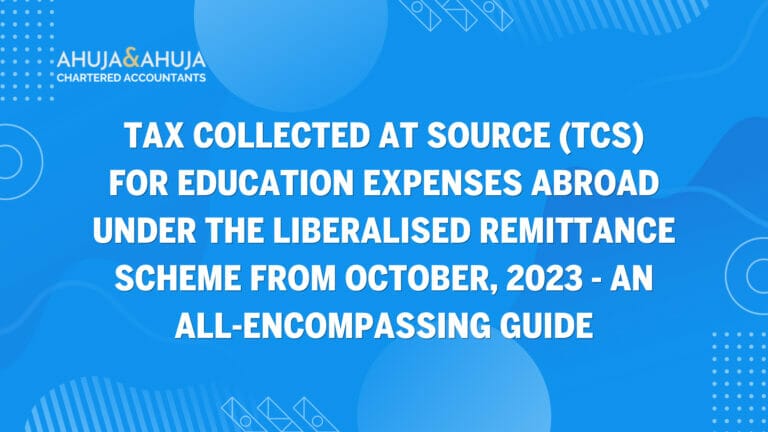TDS/TCS Compliance Pitfalls: Common Mistakes, Regulatory Risks & How to Avoid Penalties
For every business and many individuals, TDS (Tax Deducted at Source) and TCS (Tax Collected at Source) are not just routine tax formalities—they are the backbone of India’s tax collection system. The government relies on these mechanisms to ensure a steady inflow of revenue and to widen the tax net. But with this importance comes a heavy compliance burden. Even a small slip—like missing a deadline or entering a wrong PAN—can trigger a chain of penalties, interest, and even prosecution.
The High Cost of Non-Compliance
Non-compliance with TDS/TCS provisions is not a minor oversight. The consequences can be severe:
- Financial Penalties: Interest, late fees, and penalties can quickly add up, sometimes exceeding the original tax amount.
- Expense Disallowance: Businesses risk losing tax deductions on major expenses, directly impacting profits.
- Legal Trouble: Persistent defaults can even lead to prosecution.
- Operational Disruption: Notices, reassessments, and blocked refunds can disrupt business cash flows and reputation.
For many, the pain is not just in paying penalties, but in the time and resources spent on firefighting compliance issues that could have been avoided with the right systems in place. Organizations across locations such as Delhi and Chandigarh frequently seek expert help to manage these risks efficiently.
What This Article Will Cover
This article is designed as a practical guide for CAs, business owners, and finance teams who want to avoid the most common TDS/TCS compliance traps. We’ll break down:
- The nuts and bolts of TDS/TCS forms, deadlines, and obligations
- The most frequent compliance mistakes and why they happen
- The regulatory risks—interest, penalties, and expense disallowance
- Stepwise, actionable solutions to strengthen your compliance process
Each section addresses real-world pain points, with a focus on prevention, remediation, and leveraging technology for peace of mind.
The Mechanics of TDS/TCS: Understanding Forms, Due Dates & Core Obligations
Before we tackle the pitfalls, let’s get the basics right. TDS and TCS compliance starts with knowing which forms to file, when to file them, and what your core obligations are.
TDS/TCS Return Forms: What, When, and Why
- Form 24Q: For TDS on salaries—filed quarterly by employers, with a detailed breakup in the fourth quarter.
- Form 26Q: For TDS on non-salary payments—like contractor fees, rent, or interest.
- Form 27Q: For TDS on payments to non-residents and foreign entities.
- Form 27EQ: For TCS—filed by sellers/service providers who collect tax at source.
Why does this matter?
Each form is tailored to a specific type of transaction and deductee. Filing the wrong form, or mismatching details, can lead to credit denial for the payee, higher TDS rates, and regulatory scrutiny. For detailed understanding, see our TDS/TCS Return Filings service.
Key Compliance Deadlines: No Room for Delay
Missing a deadline is one of the most common—and costly—mistakes. Here’s a quick reference:
| Quarter | TDS Return Due Date | TCS Return Due Date |
|---|---|---|
| April – June | 31st July | 15th July |
| July – September | 31st October | 15th October |
| October – December | 31st January | 15th January |
| January – March | 31st May | 15th May |
Why so strict?
The law is clear: timely deduction, deposit, and reporting are non-negotiable. Delays attract interest, late fees, and can even block expense claims.
The Golden Rule: Deduct at Payment or Credit, Whichever is Earlier
This is the single most misunderstood principle. TDS must be deducted when you either pay or credit the amount to the payee’s account—whichever happens first. Many businesses slip up by waiting until payment, missing the accrual date, and falling into the penalty trap.
Common Compliance Pitfalls & Systemic Root Causes
Even the most diligent businesses can stumble on TDS/TCS. The real danger lies not just in isolated mistakes, but in patterns—systemic gaps that quietly build up risk. Let’s break down the most frequent scenarios, their root causes, and how you can build a process that catches errors before they snowball.
Frequent Scenarios: Where Most Slip-Ups Happen
- Missing the Right Deduction Timing
- Unawareness of Accrual vs. Payment Rules: Many teams believe TDS is only due when cash actually leaves the account. In reality, the law requires deduction at the earlier of payment or credit. If you book an expense in March but pay in April, TDS is due in March itself.
- Decentralized Vendor/Expense Processing: When multiple departments handle payments, communication gaps can lead to missed deductions—especially for year-end provisions or ad-hoc payments.
- Manual Processes & Human Error: Relying on spreadsheets or manual tracking is a recipe for oversight, especially during busy periods or staff turnover.
- Non-Standardized Authorizations: If there’s no uniform checklist or approval workflow, deductions can be missed when new vendors or expense types are introduced.
2. Delayed Deposit of TDS
Even after correct deduction, delays in depositing TDS with the government are common—often due to cash flow crunches, missed reminders, or confusion over due dates.3.Inaccurate ReportingErrors in PAN, challan details, or deductee information can lead to higher TDS rates, denial of credit, and regulatory notices.
Systematic Identification & Prevention
The good news? Most pitfalls are preventable with the right systems and discipline.
Automate Trigger Points with ERP Integration:
Modern accounting or ERP systems can flag TDS obligations the moment an expense is booked or a vendor invoice is processed. This ensures deduction is never missed at the accrual stage.Mandatory Checklists & Workflow Approvals:
Build a standard checklist into your payment process. No payment or booking should proceed without a TDS review—ideally with a “maker-checker” system for added control.Regular Internal Audits:
Schedule monthly or quarterly reviews of expense ledgers, vendor payments, and TDS registers. Early detection of missed deductions or deposits allows for timely correction and minimises penalties.Calendar-Driven TDS Schedulers:
Use digital calendars or compliance software to set up automated reminders for deduction, deposit, and return filing deadlines. This is especially useful for businesses with high transaction volumes or multiple branches.
For businesses in Jodhpur or Moradabad, integrating these automated compliance tools with your finance processes can significantly reduce risks.
Example:
A mid-sized trading company integrated its accounts payable system with a TDS module. Every time a vendor bill was entered, the system auto-checked the nature of payment, applicable TDS section, and flagged deduction requirements. This single change reduced missed deductions by over 90% in the first year.
Late Deposit of TDS: Interest, Penalties & Rectification
Even if you deduct TDS on time, a delay in depositing it with the government can be costly. The law is strict—interest and penalties apply from the day after deduction until the actual deposit date.
Interest Calculation under Section 201(1A)
- Rate: 1.5% per month or part thereof, from the date of deduction to the date of deposit.
- Compounding Nuance: Even a one-day delay counts as a full month for interest calculation.
Practical Example Table:
| Date of Deduction | Due Date for Deposit | Actual Deposit Date | Delay (Days) | Interest Period (Months) | Interest Rate |
|---|---|---|---|---|---|
| 28th Feb | 7th Mar | 10th Mar | 3 | 1 | 1.5% |
| 31st Mar | 30th Apr (for Mar) | 15th May | 15 | 2 | 3% |
Note: For TDS deducted in March, the due date is 30th April. Any deposit after that attracts interest for each month or part thereof.
Steps to Rectify a Late Deposit
Immediate Deposit:
As soon as you spot the delay, deposit the TDS along with calculated interest. Don’t wait for a notice—proactive action reduces further risk.File Correction Statement:
Update your TDS return to reflect the actual deposit date and challan details. This ensures records match and prevents future mismatches or notices.Communicate with Authorities (if needed):
If you receive a notice, respond promptly with proof of deposit and interest payment. Early, transparent communication can sometimes mitigate additional penalties.
Proactive Measures to Minimize Further Penalties
- Set Up Automated Alerts:
Use compliance software or even simple calendar reminders for all TDS deposit due dates. - Maintain a TDS Deposit Register:
Track every deduction and deposit in real time, with cross-verification against bank statements and challans. - Regular Reconciliation:
Match your TDS ledger with Form 26AS and TRACES portal data to catch discrepancies early. Learn more about Form 26AS in Income Tax.
Errors in PAN/Deductee Details: Data Quality, Regulatory Impact & Controls
A single typo in a PAN or a mismatch in deductee details can snowball into major headaches for both deductor and deductee. The consequences are immediate and severe:
- Higher TDS Deduction (20%): If the PAN is invalid or not quoted, TDS must be deducted at a flat 20%, regardless of the applicable rate.
- Credit Denial for Deductee: The deductee may not get credit for TDS in their Form 26AS, leading to tax demands or refund delays.
- Risk of Notices and Reassessment: Incorrect details can trigger scrutiny, notices, and even reassessment proceedings.
How to Prevent Data Errors?
- Exception Reports & Maker-Checker Mechanisms:
Always run exception reports before filing returns. Implement a maker-checker process—one person enters data, another verifies. - PAN Validation Tools & Bulk Verification:
Use the Income Tax Department’s online PAN verification utility or bulk PAN validation tools before uploading returns. - Checklist Before Submission:
Cross-check all deductee details, challan numbers, and amounts. A simple pre-submission checklist can prevent most errors.
To understand implications of incorrect PAN data, read our article on Consequences of Duplicate PAN Card and How to Avoid Them.
Reporting Discrepancies Across Quarters & FYs: Risk and Resolution
Reporting TDS/TCS in the wrong quarter or financial year is a classic compliance pitfall. The fallout can be significant:
- Regulatory Consequences:
- Interest and penalties for late deduction/deposit.
- FVU (File Validation Utility) restrictions—TRACES will reject returns with mismatched periods.
- Disallowance of Expenses:
- Under Sections 40(a)(ia)/(i), expenses may be disallowed if TDS is not deducted/deposited in the correct period.
How to Fix Reporting Mismatches?
- Correction Statements:
- File a correction statement for the original quarter/FY where the transaction occurred.
- For same-year corrections, the process is straightforward. For lapsed FYs, stricter validations apply—ensure all dates and challan details match the original period.
- Timelines and Technical Constraints:
- TRACES validations are strict—dates must align with the actual financial year and quarter.
- Ledger Reconciliations:
- Regularly reconcile your TDS ledger with books and Form 26AS to catch mismatches early.
For detailed insights on form correction and validation, see our TDS/TCS Return Filings service.
Omissions in Deduction: Late Discovery & Expense Disallowance
Sometimes, TDS is not deducted at all in the relevant period and is discovered only later. Here’s what you need to do:
Late Deduction/Deposit Remediation:
Calculate Interest:
- 1% per month (or part) from the date tax was deductible to the date of actual deduction.
- 1.5% per month (or part) from the date of deduction to the date of deposit.
File Correction Statement:
- Report the deduction and deposit in the original period via a correction statement.
Monitor Assessment Year Alignment:
- Ensure the deduction and deposit are reflected in the correct assessment year to avoid expense disallowance.
Effect on Expense Claims:
Immediate Disallowance:
- 30% (for residents) or 100% (for non-residents) of the expense may be disallowed if TDS is not deducted/deposited by the due date of return filing.
Relief on Subsequent Compliance:
- If TDS is later deducted and paid, the expense is allowed in the year of compliance, but interest and penalties still apply.
Form 71: Bridging TDS Credit Mismatches Across Years
Introduced in October 2023, Form 71 is a game-changer for deductees facing TDS credit mismatches due to timing differences:
Rationale:
Sometimes, the deductor deducts and deposits TDS in one FY, but the deductee offers the income in another FY. This leads to credit mismatch in Form 26AS and ITR.
Eligibility:
Deductee can file Form 71 within two years from the end of the FY in which income is offered to tax.
Procedure:
Submit Form 71 online with supporting documents.
The tax department processes the request and allows TDS credit in the correct year.
Practical Use Case:
A consultant receives payment in April (FY 2024-25), but the client deducts TDS in March (FY 2023-24). The consultant can use Form 71 to claim credit in FY 2024-25.
Myths & Misconceptions: The Realities of the TDS/TCS Correction Process
Many believe that TDS/TCS errors can be fixed anytime without penalty. This is a dangerous myth.
- Correction Timelines Are Not Unlimited:
- Late corrections still attract interest, late fees, and possible expense disallowance.
- Regulatory Reality:
- Ongoing defaults continue to accrue penalties until fully rectified.
- Strategic Compliance:
- Aim for “first time right” compliance. Build robust processes to prevent errors rather than relying on post-facto corrections.
Timely Issuance of TDS/TCS Certificates: Process and Penalty Avoidance
Issuing Form 16/16A on time is not just a formality—it’s a legal obligation.
- Process:
- Use TRACES portal to generate and download certificates.
- Automate issuance wherever possible.
- Deadlines:
- Form 16 (salary): By 15th June after the end of the FY.
- Form 16A (non-salary): Within 15 days from the due date of TDS return filing.
- Penalties:
- Rs.100 per day per certificate for delay or non-issuance.
- Best Practices:
- Set up automated reminders and integrate certificate generation with your TDS return filing process.
Harnessing Technology: Compliance Monitoring Tools and Software Automation
Manual compliance is a recipe for errors. Technology can be your best ally:
- Features of Compliance Software:
- Deadline tracking, automated reminders, error detection, PAN validation, and real-time reconciliation with Form 26AS.
- Choosing the Right Tool:
- Look for solutions that integrate with your accounting/ERP system and offer dashboard views for management.
- Case Study:
- An SME adopted a cloud-based TDS compliance tool. Missed deadlines dropped to zero, and penalty outgo reduced by 80% in the first year.
To explore comprehensive finance and tax-related services, visit our Finance Services page.
Circumstances and Documentation for Avoiding Expense Disallowance via Form 26A
If you missed TDS deduction but the payee has paid tax on the income, you can avoid expense disallowance by:
- Obtaining Form 26A:
- Get a CA certificate confirming the payee has filed their return, included the income, and paid tax.
- Timeline:
- Complete this process before the end of the assessment proceedings.
- Documentation Checklist:
- Copy of payee’s ITR, tax payment challan, and Form 26A certificate.
- Ongoing Monitoring:
- Track all such cases and maintain a robust audit trail.
You can read more about the use of Form 26A and credit mismatches in our blog on Learn All About Form 26AS in Income Tax.
Summary Table: Pitfall, Regulatory Risk, and Actionable Solution
| Pitfall | Regulatory Risk | Actionable Solution |
|---|---|---|
| Late deduction/deposit | Interest, penalty, disallowance | Automate triggers, set reminders |
| Wrong PAN/deductee details | Higher TDS, credit denial | PAN validation, maker-checker process |
| Wrong quarter/FY reporting | Penalties, FVU rejection | Timely correction statements, reconciliation |
| Missed deduction | Expense disallowance, interest | Immediate deduction, Form 26A if eligible |
| Late certificate issuance | ?100/day penalty | Automate certificate generation |
Best Practices Checklist: Fortifying TDS/TCS Compliance
- [ ] Automate deduction triggers in your ERP/accounting system
- [ ] Use PAN validation and exception reports before filing
- [ ] Set up calendar reminders for all due dates
- [ ] Reconcile TDS ledgers with Form 26AS quarterly
- [ ] File correction statements promptly for any errors
- [ ] Issue TDS/TCS certificates on time—automate if possible
- [ ] Maintain documentation for Form 26A/Form 71 cases
- [ ] Train staff on latest compliance requirements
- [ ] Review compliance dashboard monthly with management
Conclusion
TDS/TCS compliance is not just about ticking boxes—it’s about protecting your business from financial, legal, and reputational risk. The cost of complacency is high, but with the right processes, technology, and professional oversight, you can turn compliance from a pain point into a strategic strength. Prioritise accuracy, timeliness, and continuous improvement—your bottom line will thank you.
For expert guidance and assistance, connect with our chartered accountants in Gurgaon, who specialize in comprehensive tax compliance management.
Disclaimer
The materials provided herein are solely for educational and informational purposes. No attorney/professional-client relationship is created when you access or use the site or the materials. The information presented on this site does not constitute legal or professional advice and should not be relied upon for such purposes or used as a substitute for professional or legal advice.






